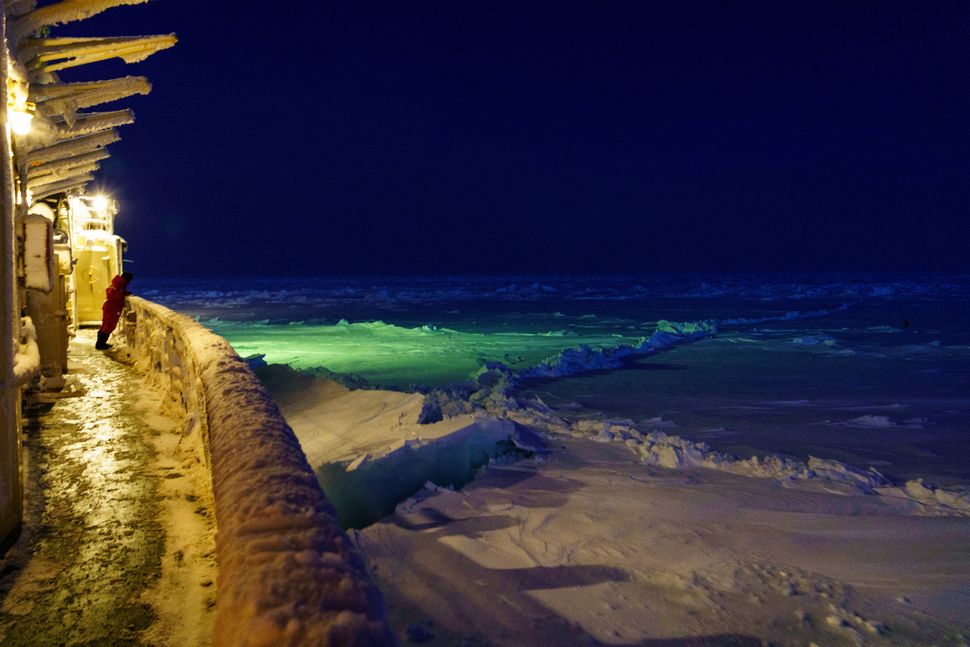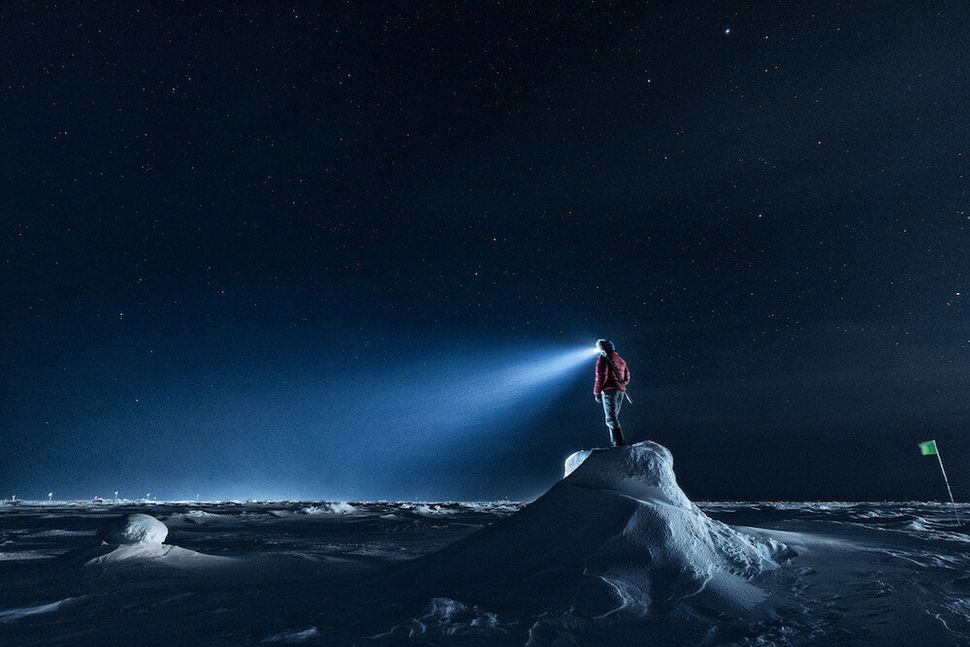Thunderous creaks and crashes reverberated throughout the lower decks of the Kapitan Dranitsyn in February as it carved a course through 1,000 miles of dense Arctic ice pack toward the North Pole.
The sound was incredible, said Jeff Bowman, a biological oceanographer at Scripps Institution of Oceanography at UC San Diego, like steel being shredded. “It’s the sound of every shipwreck movie that you’ve ever watched — but amplified. It’s quite a horrific sound, and that never ceases so long as the ship is moving.”
For four weeks, the Russian icebreaker inched at a walking pace through the ice to deliver Bowman and 60 other scientists and engineers to the Polarstern, a 400-foot ship that had been lodged within the sea ice for nearly five months. Once aboard, they would join in an unprecedented yearlong research mission to the northernmost reaches of the Earth, collecting data crucial to understanding and predicting climate changes affecting the entire globe.

What happens in the Arctic impacts global weather patterns, atmospheric carbon and sea level rise. Arctic ice sheets are melting at alarming rates and the region is warming twice as fast as other parts of the world.
Launched in September, the $160.3 million MOSAiC (Multidisciplinary drifting Observatory for the Study of Arctic Climate) program is the largest Arctic expedition in history. A collaboration among a consortium of international polar research institutions led by Germany’s Alfred Wegener Institute, it is the first time scientists will be able to measure climatic conditions in the Arctic at every point in the year — including in the middle of winter, when it is dark 24 hours a day, the ice is at its thickest, and temperatures fall as low as minus 40 degrees (which, in addition to being brutal for researchers and causing the malfunction of critical machinery, happens to be the temperature at which the Celsius and Fahrenheit scales converge).
To make this possible, the Polarstern — the center of the expedition and one of the world’s most powerful icebreakers — is locked among the floes to drift with the natural movement of the sea ice for 12 months, from the coast of Siberia across the pole toward Greenland.

If Polarstern is the International Space Station, the Kapitan Dranitsyn is one of several space shuttles bringing supplies and a rotating assembly of hundreds of researchers from 20 countries, and returning others home.
After leaving the Norwegian city of Tromsø in the relative warmth of September, the Polarstern wound its way to the 85th parallel — 5 degrees shy of the North Pole — through ice that was fragmented and easier to penetrate. When it encountered an ice floe big enough to support operations, it moored, letting the shifting frozen landscape enclose it. Nature would chart its course from there.
Around the ship, crew erected a temporary city of research stations called the “ice camp,” with monitors and sensors stretching as far as 20 miles away. From there, researchers are studying the ice itself and measuring changes in thickness. Some bore holes through it to capture fish and test the temperature and salinity of the water as far as 2.5 miles down. They launch weather balloons and drones into the air, monitoring wind and humidity, and sensing aerosols that have traveled from distant parts of the globe. Six guards keep lookout for polar bears.

“By having Polarstern be a central observatory, you can have people on the ice throughout the day, for months and months at a time,” said Frank Rack, a MOSAiC program manager from the National Science Foundation.
Whereas in Antarctica there are permanent research stations to serve as bases for scientific expeditions, “that simply doesn’t happen in the central Arctic, because there is no land,” Bowman explained. “It’s ocean. The only way you can do it is by putting a ship there. And the number of ships that are capable of doing that are very, very few and far between.”

Bowman, one of about 90 Americans on the mission, was in the third wave of researchers to arrive at the ice camp. His research focuses on microscopic organisms that live in the upper regions of the ocean. The Amazon rainforest may be known as the lungs of the planet, he said, taking in carbon dioxide from the atmosphere and breathing out oxygen, but about half of the photosynthesis that takes place on Earth is being carried out by single-celled phytoplankton at the ocean’s surface.
Only a fraction of that is happening in the polar North, but it’s an important fraction that scientists know very little about. From their position at the bottom of the food chain, “these phytoplankton communities really drive the dynamics of the ecosystem ... but we don’t have a baseline understanding of what that ecosystem is doing,” Bowman said.
MOSAiC is giving researchers their first look at how the process changes as the ice melts and freezes, in a part of the Earth where the sun — the very engine of photosynthesis — doesn’t rise for months at a time. One of the things Bowman wanted to learn is how much carbon dioxide is being taken in by photosynthesizing phytoplankton versus how much ends up being released back into the air at different times — an equation that determines the net amount of carbon removed from the atmosphere and sequestered in the system.

That balance is key to predicting “whether the Arctic will become more of a source or a sink of carbon dioxide,” a heat-trapping greenhouse gas. The oceans’ absorption of heat has enormous implications for the global climate.
Bowman was supposed to stay on the Polarstern until early April, when ski-equipped jets would fly in from Svalbard, Norway, land on a runway on the ice, and whisk him and his colleagues away. But by then, the COVID-19 pandemic was spreading fast. With international travel severely limited, the April personnel exchange was postponed and the team at the Alfred Wegener Institute scrambled to arrange a stopgap solution. They requisitioned a pair of 19-seat Twin Otter planes from Canada. Bowman, with an infant son at home, scored a seat.
He left the ice on April 22, making eight connections through Greenland and Canada on his way back to California. “As you’re getting closer and closer and closer to civilization, things are getting more and more bizarre,” Bowman said, describing the journey from the pristine Arctic to the evolving chaos of the rest of the world.

The rest of the people scheduled to return in April stayed on the Polarstern until the middle of May and didn’t reach port until June. The length and timing of the remaining crew rotations have been rejiggered, but the mission will continue as planned until the ship frees herself from the ice in September.
Bowman was relieved that the pandemic didn’t shut down MOSAiC the way it has stopped field research around the world. (Really, if there’s a team equipped to handle the complex logistics of sudden disaster, it’s probably the folks who built a floating ice city at the North Pole and populated it with 600 people from 20 countries.)
“We lack these baseline observations in the central Arctic in a way that we don’t lack for virtually any other place on the globe,” he said. “So the ingenuity that has been employed to keep this thing going is very heartening to see. And it’s going to have tremendous scientific payoff.”
For more content and to be part of the “This New World” community, follow our Facebook page.
HuffPost’s “This New World” series is funded by Partners for a New Economy and the Kendeda Fund. All content is editorially independent, with no influence or input from the foundations. If you have an idea or tip for the editorial series, send an email to thisnewworld@huffpost.com.